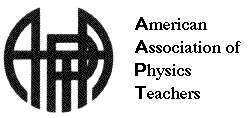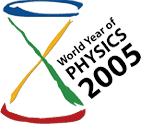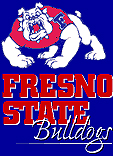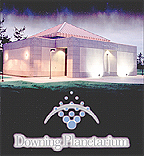

|
The Spring 2005
Meeting
Northern California/Nevada Section
AAPT
Southern California Section AAPT
Joint Meeting
Friday
& Saturday, April 8-9, 2005
|
Meeting Theme:
The World Year of Physics 2005 --
Einstein in the 21st Century
|
|
|

|
|
|
Friday Evening Social
|
|

|
April 8, 2005 ~
6:00-9:00 PM
Steven White, director of the new
Downing Planetarium, will give us a tour of
this beautiful new facility. Doors will open at 6
PM. Those who arrive by 7:00 PM will be treated to
the show
"Ringworld"--a
documentary about the planet
Saturn. Don't be
late! The planetarium is adjacent to the parking
lot at Barstow and Maple. Snacks and refreshments
will be provided by PASCO Scientific.

|

|
|
|
Saturday Program
McLane hall, Room 162
|
|
|
|
7:45 Registration,
Coffee, Donuts, and other culinary
delights.
8:45 Welcome and
Announcements
9:00 Show &
Tell
Share your favorite demonstration or
teaching tip. Since new teachers and section
members will be at this meeting, you are
encouraged to dust off some of your oldies but
goodies. If you have handouts, please bring 75
copies. Time limit is 5 minutes per
person.
10:00
Invited Speaker: "Einstein's
Quantum Theory of Radiation Revisited"
Michael Nauenberg
UC Santa Cruz (emeritus), michael@mike.ucsc.edu
In 1916 Einstein published a remarkable paper
entitled "On the Quantum Theory of Radiation"
where he derived Planck's formula for black-body
radiation by a new statistical hypothesis for
the emission and absorption of electromagnetic
radiation based on discrete bundles of energy
and momentum which we now call photons. Einstein
replaced Maxwell's classical electrodynamics by
a stochastic process, but he did not discover
the quantum statistics for photons that Bose
communicated to him seven years later. In this
talk I will also show how Einstein's theory
determines these statistics. Like Boltzmann's
classical counterpart, Einstein's statistical
theory leads to an irreversible approach to
thermal equilibrium. However, since this
violates time reversal, Einstein's theory cannot
be regarded as a fundamental theory of physical
processs. Apparently Einstein and his
contemporaries were unaware of this problem, and
even today this problem is ignored in
contemporary discussions of Einstein's treatment
of the black-body spectrum.
11:00 Invited Speaker:
"Musings on
1905"
Lewis Epstein
City College of San Francisco (retired),
thinking@prodigy.net,
(415) 826-3488
This talk will focus on Einstein's 1905
works, related topics, and questions. For
example, what does relativity say about out of
body travel and about dematerialization or
materialization and about toy trains? How did
astrology almost become science? Do molecules
really diffuse from high to low concentration?
What is "Jewish physics" and where did it come
from? A seldom mentioned, but very illustrative
anecdote from the end of Einstein's life is one
worth passing on to your grade-hungry students.
What did Einstein know about the 1887 Michelson
experiment? In 1887 what was the anticipated
result? Who was Herr Einstein in 1905? Who was
Einstein's science star? Did you know Einstein's
first job was not patent examiner? It was
as a high school physics teacher - and his
students' misbehavior ended it.
12:00 LUNCH: A delicious and tasty box
lunch will be provided for $10.
1:00 Raffle/Business Meeting: Revising
and updating our Constitution, elections, and other
agenda items.
1:45 Invited Speaker: "The Dark Century:
Matter, Energy, and the Future of the Universe"
Virginia Trimble
UC Irvine, vtrimble@uci.edu
Dark matter is a sort of shorthand for an
enormous body of evidence indicating that most
of the stuff in the universe neither emits nor
absorbs its fair share of light. Some of the
data go back more than 80 years, and there are
hints of it even earlier. Dark energy, also
called quintessence, the cosmological constant,
and even worse things, is both an integration
constant in Einstein's equations and a similar
shorthand. The database here is not quite so
extensive or so deeply grounded in history, but
still very persuasive, implying that the
universe is as flat as general relativity allows
and that its expansion is accelerating. There
are droves of candidates for both dark matter
particles and dark energy fields, though so far
no laboratory detections of any. Something can,
however, be said about their properties, which,
in turn, determine the long-range future."
~ Break ~
Contributed
Papers
3:00
"Teaching
Relativity using Spacetime Graphs"
Michael
Huster
Simpson University, Redding, CA
mhuster@simpsonuniversity.edu
I teach a general
education course about modern science for
college students who are math-phobic. I have
used spacetime graphs to explain phenomena like
the Polevaulter and the Barn paradox and the
Twin Paradox. The students plot events and
worldlines in different reference frames,
compute spacetime intervals, and interpret the
results.
3:20
"An Excel
Spreadsheet Model of Supernova Light
Curves"
Kevin
McLin
Sonoma State University, mclin@universe.sonoma.edu
As part of a NASA funded
Education and Public Outreach program for the
XMM-Newton mission, I have created an exercise
for high school students that allows them to fit
a theoretical light curve to observational
supernova light-curve data. The model light
curve uses Excel spreadsheet software and is
based on the decay of several species of
radioactive isotopes that are produced in the
stellar explosion. Students adjust the amount of
each isotope and the time step for the
calculation to produce a fit to the data.
3:40
"Physics in the
Movies"
Dan Burns
Los Gatos High School, dburns@lghs.net
Scenes from popular and
classic movies offer an engaging way to
illustrate the use of physics principles in
"real" life. Physics teachers have been
exploiting this by showing selected clips from
2001: A Space Odyssey, The Omen, and many other
movies for decades. Methods to facilitate the
editing and presentation of movie clips from
DVDs will be described. A list of 36 movie clips
will be distributed and ideas for classroom use
will be discussed. Attendees will leave with
resources to allow them to easily use these
clips in their classrooms.
4:00 "Help for Physics
Teachers"
Andria
Erzberger
retired, PTRA, andriae@mac.com
Many high school physics
and physical science teachers have little
physics in their backgrounds. An NSF program
gives help to those teachers through local
colleges and universities. The first workshop in
California will be held in the Central Valley
June 27-July 1. This first summer teachers will
study motion and forces, use low- and
high-tech equipment, practice
inquiry, receive housing and a stipend, and may
receive graduate physics credit. How do high
school teachers get involved? How are colleges
selected to host this program?
4:20
"CHICOS"
Sarah Johnson
University of La Verne, johnsosa@ulv.edu
The CHICOS project,
operated by the Kellogg Laboratory at Caltech,
represents a unique blending of cutting-edge
scientific research and broad-based educational
outreach. CHICOS is an
active research array for the detection of
ultra-high energy cosmic rays. The array as
presently deployed has already seen extended air
showers, and the soon-to-be-completed
CHICOS 90 array will observe with large aperture
in the energy range from 1018 to
1021 eV, with the angular resolution
to address questions of clustering in several
years of run time. In the CHICOS project,
schools across the Los Angeles area provide the
"net" of detector sites with ready-made
infrastructure and a valuable population of
teachers and students who participate in the
project.
4:40 "What Can You
Do with a Bachelor's Degree in Physics?"
Joe Tenn
Sonoma State University, joe.tenn@sonoma.edu
As I conduct the annual
poll of our graduates I am once again struck by
the many ways in which they make use of their
physics educations. Besides the
obvious--physicists, astronomers, teachers,
engineers, and computer programmers -- there are
CEOs, pilots, physicians, a patent attorney, and
an actress on Broadway. I will present some data
and quotes from graduates about the utility of a
physics degree. You can see what 58% of Sonoma
State University's physics graduates are doing
at http://phys-astro.sonoma.edu/.
|
Order of Magnitude
Question
Submit your answer at the meeting and win one of
several terrific prizes.
"How long does it take for a gallon of gasoline
to be burned on US roads?"
|
Directions to CSU Fresno
|
Hotels Nearby
|
|
• From Highway 99
North, take the Shaw Ave. (west) exit, go about 5
miles and turn left on Cedar Ave. Fresno State is
between Shaw and Barstow Avenues. Turn right onto
Barstow. Turn right onto Maple and park. Follow the
signs from there.
• From Highway 99
South, take Highway 168 East exit to Shaw Ave
(east). Continue on Shaw Ave. and turn right on
Cedar Ave. Fresno State is between Shaw and Barstow
Avenues. Turn right onto Barstow. Turn right onto
Maple and park. Follow the signs from there.
|
|
University
Inn
|
Ramada
Inn
|
|
$57.99 (1
mile away)
2655 E. Shaw Ave.
Fresno, CA 93710
(559) 294-0224
|
$70 (2.7
miles)
324 E. Shaw Ave.
Fresno, CA 93710
(559) 224-4040
|
|
Picadilly
Inn
|
Red
Roof Inn
|
|
$74 (1.2
miles)
4961 N. Cedar Ave.
Fresno, CA 93726
1-(800) HOTEL-US
|
$57.99
(4.1 miles)
6730 N. Blackstone Ave.
Fresno, CA 94306
(559) 431-3557
|
|
Quality
Inn
|
|
|
$79-99
(2.5 miles)
480 E. Shaw Ave.
Fresno, CA 94306
(559) 229-5811
|
|
|
Registration Fee
|
Upcoming Events
|
PTSOS News
|
What a
deal!
*fee is waived for first-time attendees
and students! The rest of us pay only $15. A
bargain at twice the price!
|
Summer, AAPT National Meeting
August 6-10, 2005 University of Utah
Salt Lake City, UT
Fall, NCNAAPT Section Meeting
November 4-5, 2005
TBA
Winter, AAPT National Meeting
January 21-25, 2006
Anchorage, Alaska
•Spring,
NCNAAPT Section Meeting
April, 2005
TBA
|
Attention New Physics
Teachers! PTSOS is coming!
PTSOS is an NCNAAPT-sponsored project funded by
a donation from the Karl Brown Foundation, that
assists physics teachers in their vulnerable first
years of teaching. PTSOS is headed by
Paul Robinson, Dean Baird,
Stephanie Finander. The next round of
workshops will begin next fall. New teachers
should email Stephanie Finander at
sfinander@aol.com for more information on
how to get signed up for next year's program now.
|

Updated 28 March 2005
|




